MAM vs DAM: A Blurred (But Distinct) Line For Brands
Any company that uses a lot of media assets will face the same issue — storing, managing, and searching through files can be time-consuming.
For organizations that need to store hundreds or thousands of assets, figuring out how to manage them productively can be challenging. And that's where a Media Asset Management (MAM) system comes into play. Similarly to how a Digital Asset Management (DAM) system works, a MAM system gives companies an easy way to manage their growing media asset libraries. Simply put, if you have a DAM in place, you likely also already have some form of MAM but with less of an emphasis on video production.
If you invest in a MAM system, you'll have an easier way to manage content, and you’ll significantly reduce the time your team spends searching for content files. You can also see how DAM does video asset management.
What is Media Asset Management (MAM)?
Media Asset Management (MAM) is the use of software to store and manage media assets to make them easily accessible and searchable.
MAM software is designed to store and organize large quantities of assets so cross-functional teams can locate files quickly when they are collaborating on a project together. As it centralizes a company's entire asset library, a MAM platform becomes a single source of truth for updated files and correct branding assets while keeping everything neat and organized.
Investing in a MAM allows your company to:
- Manage and organize thousands of assets
- Collaborate and work on files
- Comment and leave feedback for other team members
- Restrict access to certain assets
- Easily search through thousands of files to find assets using metadata
- Implement version control
- Manage video workflows
MAM allows your team to be more productive. It's basically a giant digital library that keeps every media asset and production file your company has organized, up-to-date, and easy to find.
MAM vs. DAM: What’s the Difference?
Even though Media Asset Management (MAM) and Digital Asset Management (DAM) systems sound quite similar, there are some key differences you should know about.
Yes, they both make it easy to store large asset libraries, collaborate, and share files securely. MAM was originally created to support video, but many of its features are now available in top-tier DAM platforms.
So, what exactly are the differences between the two? We have the answers:
MAM
When it was first created, MAM focused on storing and archiving video assets, particularly multimedia and audio content.
Because MAM is geared towards industries that work in the production phase of multimedia projects, like designing and editing, it’s capable of handling large files and complex tasks like transcoding and subtitling.
Benefits
- Cloud editing of multimedia, audio, and proxy files
- Storing and archiving of large-format audio and video assets
- Workflow management that’s perfect for video creation
- Permission-based access to assets
- Prepare and transcode multimedia assets for editing and final cuts
- Review and approve rough and master versions of multimedia files
Best for: Companies that work with production assets, like editing studios and multimedia agencies.
DAM
DAM is a more generalized asset management tool that’s designed to make it easier for brands to manage, store, and share digital assets.
Not only can you upload assets into a DAM, but you also have complete control over access permissions, collaboration tools, and approvals. Additional features like metadata and versioning make it easier to search for assets and recognize those that are most current, which all helps your team use the correct assets every time.
Benefits
- Managing and storing deliverables for a wide range of file types
- Tracking version history for each asset in your library
- Enriching assets with features like tags and metadata
- Sharing and collaborating with team members from inside the DAM system
- Creating custom access permissions for your team and external contractors
- Using templates to create consistent brand assets
- Getting detailed metrics on brand asset usage and engagement
Best for: Organizations looking for an all-inclusive tool to organize large digital asset libraries.
Which system is best for you? That depends on the individual needs of your company. Some businesses use both a MAM and DAM platform at different stages of the production cycle.
Why Companies Invest in Media Asset Management Systems
The biggest benefit for companies who are thinking of investing in media asset management software is control.
Without some type of asset management software, you can lose a lot of hours trying to manage assets, especially when your media library is growing. Investing in a MAM system makes it easier to manage, store, search for, and share assets in a well-organized database.
Ask any company why they invest in a MAM, and they’ll likely tell you it’s because:
- Finding documents is quick and easy
- Every asset is stored and managed securely
- Assets can be shared between people and teams
- Version control ensures assets are never permanently deleted
Teams can also view version history within each asset and set permissions so only certain people can access or edit a file. When you consider all of these features, it’s easy to see how investing in a MAM system can greatly improve a company’s workflow.
Before you start shopping for MAM software, make sure you know what it can (and can’t) do.
Core Functions of Any Asset Management Software
Now that you know just how valuable a MAM system is, we’ll talk about some features you should look for.
Some MAM tools offer basic features, while others provide a robust set of features for managing media libraries. Here are some of the capabilities you should look for when looking for a MAM system:
Store large media (video and audio) files
Whether you have a small media asset library or one that's growing, one of the most important features in a MAM system is its storage capabilities.
MAM systems offer storage in the cloud, which means assets are always available to your team wherever they are.
The difference between MAM storage and other cloud offerings (like Dropbox or Google Drive is how assets are organized. Assets that are used infrequently will be archived in a MAM system to save storage space. In contrast, frequently used assets are easily searchable and filed away using metadata and folders.
Instead of paying for expensive on-premise solutions, a MAM system allows companies to store huge asset libraries for a fraction of the cost.
Set content-based user permissions
MAM systems give you complete control over every asset in your library — including who has access to view and edit them.
A good MAM system will allow you to set content-based user permissions for single assets or entire libraries. This way, you can grant access to files to certain departments or restrict what assets external clients can view.
A DAM solution like Brandfolder will allow users to set an expiration date on a Collection of assets to make them unavailable after a timeframe.
Create video production workflows
A common misconception about MAM systems is that they are just platforms for storing and sharing files, but that’s not the case.
A MAM system can completely revolutionize the way teams collaborate and produce video content. Creators can use features like comments, automated metadata, and sharing capabilities to work together and finalize video production from inside a MAM system.
Search with metadata
MAM software allows teams to search through thousands of assets instantly, using metadata.
Metadata is information attached to each asset that helps users find it. A MAM system can attach information to an asset — like the date it was created and who created — it as well as searchable tags like filenames, descriptions, and asset type.
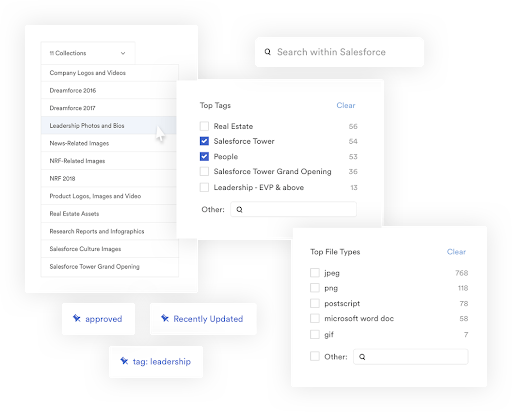 *An example of how to tag assets using Brandfolder*
*An example of how to tag assets using Brandfolder*
For example, using a tool like Brandfolder, you can easily look for assets based on certain search terms:

Depending on what metadata is attached to each asset, Brandfolder will then find every file related to the search term and compile them into a list.
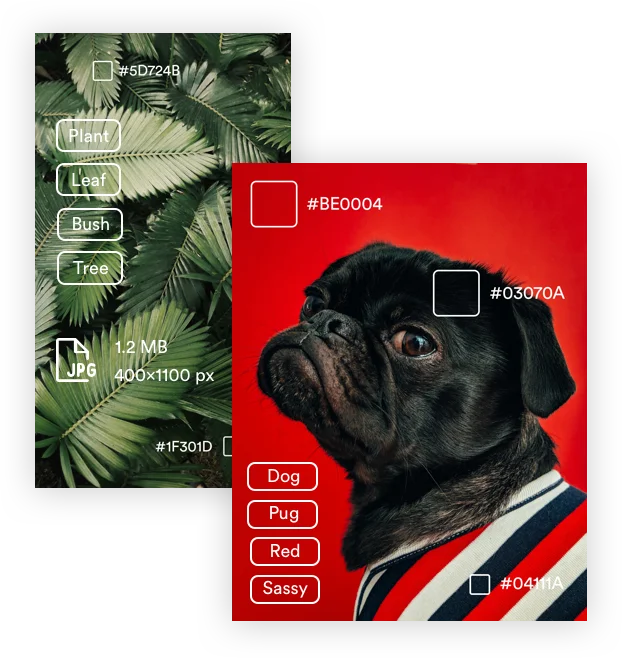
In addition to intuitive search functionality, Brandfolder’s AI-powered auto-tagging feature helps reduce manual workload by automatically adding logical tags to media assets upon import.
Collaborate across cross-functional teams
Dispersed media libraries come with a range of problems, like assets that haven’t been updated and a lack of tools cross-functional teams can use to collaborate.
With a MAM system, teams can easily share assets, collaborate on projects, and have a single source of truth for every file they're working on. And because the assets are stored in the cloud, teams can work on projects remotely.
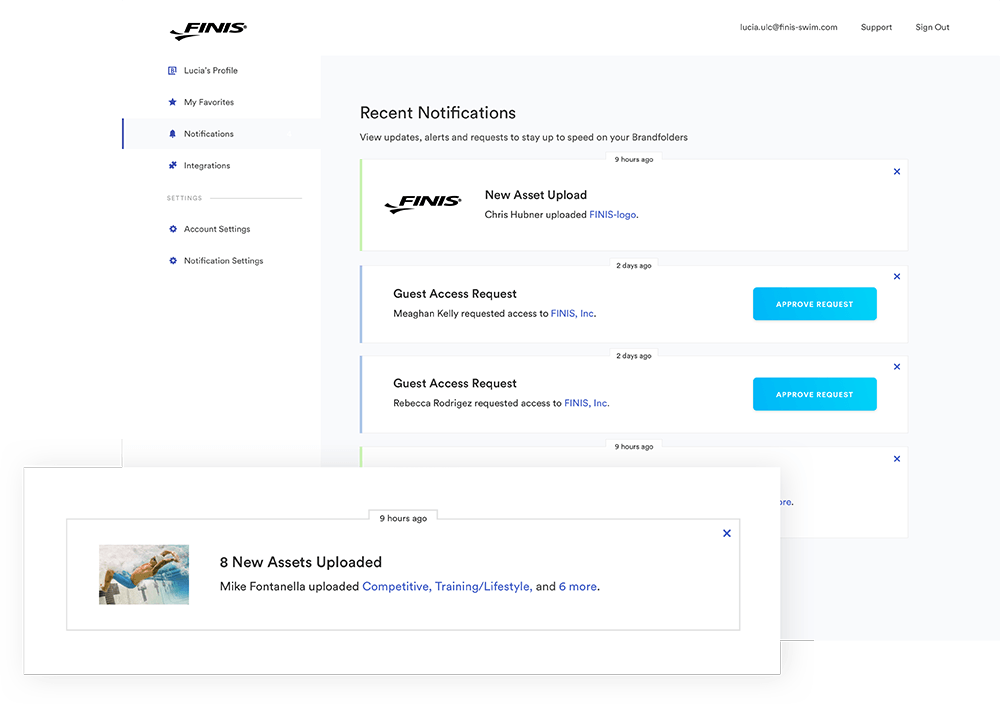
Use media versioning
Keeping track of what assets, like logos and branding, are the current versions can be difficult.
With MAM systems, you can add updated versions of existing assets and restrict access to previous versions. When someone from marketing or sales uses a logo or branding asset for a campaign, they won't have to worry about whether it's the correct, updated version.
As storage isn't an issue, you can keep existing versions of every asset in your library. Should a client ever want to review their old branding, you’ll be able to access it quickly.
Review and approve assets
How many times have you been working on a project with another team member or a client, and you were delayed waiting on someone’s feedback or approval?
Using email trails and comments can be time-consuming and hard to track. A MAM system allows you to assign review and approval tasks to team members and clients directly from the asset library. Using Brandfolder’s Simple Workflow features, you can ask project managers to review key assets and approve them before you send them out to a client:
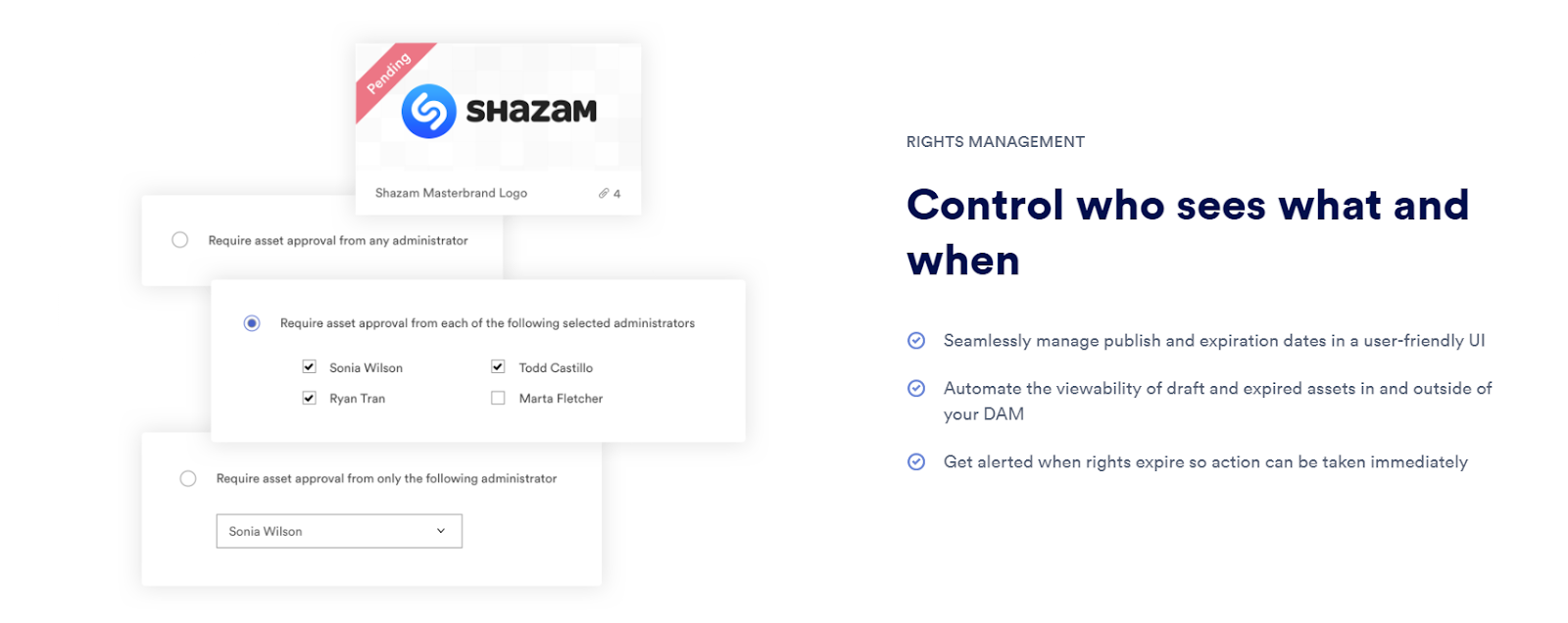
The team member tagged will then receive an email notification telling them that an asset requires their approval. And once they sign off on it, it can then be sent out to your client for final approval.
Store and Share Files Securely
Keeping your assets secure is essential, especially if you work with sensitive documents or create material for external clients.
A good MAM system will not only offer online protection for your entire asset library, but it will also conduct risk assessments and backups to make sure your material is safe at all times.
For example, a MAM system like Brandfolder uses Amazon Web Services (AWS) and Google Cloud to store backups of every file you keep on the system, so if something goes wrong, your assets are protected. There is also added protection like:
- Independent third-party examination
- Secured with SHA256/RSA signed certificates and encrypted using HTTPS to protect against eavesdropping, tampering, and message forgery
- Administrative access using key-card and/or 2FA user authentication
Sharing files is secure, too. When you share assets with an external source, you can restrict access by making the link private, requiring an email address, or setting an expiration date or time:
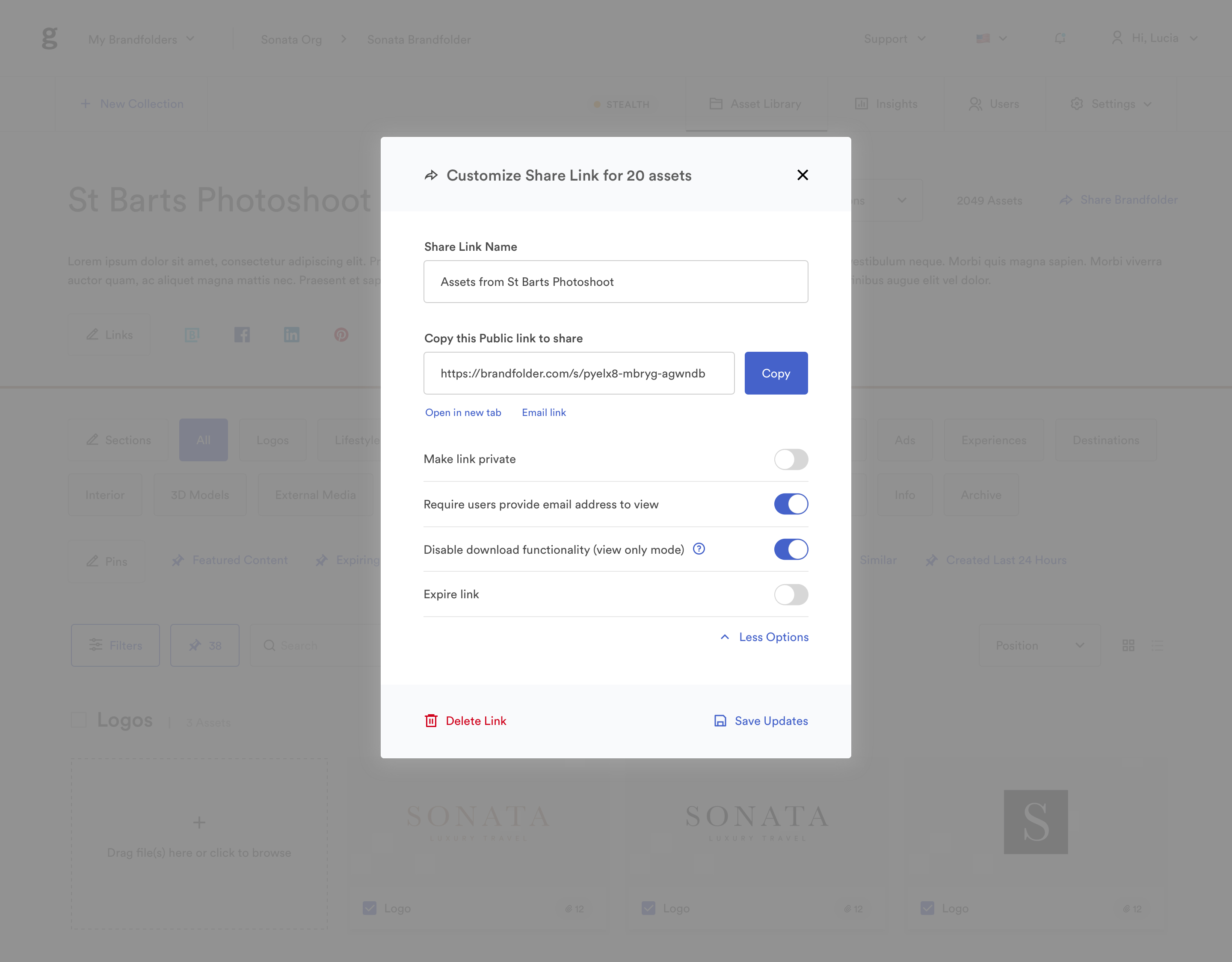
The Line Between MAM and DAM is Blurred
The difference between MAM and DAM used to be clear: MAM was for video files, while DAM was for general organizing. If you wanted the best of both worlds, you needed to invest in two systems.
Now, the line is a little more blurred.
There is confusion around what system is better because there are now a lot of feature overlaps between MAM and DAM software. Both systems can now store and manage assets and give companies a way to secure large media asset libraries. DAM systems have evolved to allow for creative asset management, in addition to file and workflow management.
Tools like Brandfolder can now handle most of the functionality of a traditional MAM while providing additional functionality like asset protection, analytics, and more collaborative content management workflows. Whereas video production teams in the past favored MAM systems, the industry is increasingly looking at DAM systems for their content production because they support a broader range of assets — not just video and audio.
Is MAM or DAM the Best Decision for Your Business?
If you are creating niche content and are looking for a system that focuses on video-production workflows, a MAM system may be better suited to your needs. However, DAM systems are a better solution for companies that want a full-service platform to manage assets, from storage to collaboration and secure sharing.
Want to see if Brandfolder is a good fit for your company? Sign up for a free demo here!
